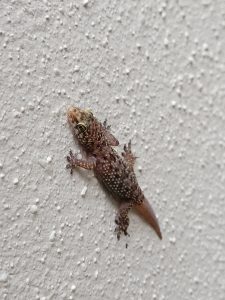Introduction
Among the ten species of geckos found in Florida, only one, the Florida Reef Gecko (Sphaerodactylus notatus), is native to the state, the additional ten non-native species found in the state having arrived in cargo or via the pet trade. Among them are the Mediterranean Gecko (Hemidactylus turcicus) first identified in 1910 in Florida, the Tropical House Geckos (Hemidactylus mabouia), and the common House Gecko (Hemidactylus frenatus).
Description
In general, geckos are small, ranging in size from 3” to 6” snout to tail, and can move quickly. Characteristics common among geckos are bulbous eyes, vertical slit-like pupils, and digits with sticky toe pads (lamellae or spike-like scales on their toes). The lamellae enable geckos to climb smooth and vertical walls and ceilings. They can range in color from semi-transparent to grayish to darker brown, with or without dark chevron markings and lateral stripes on the back which enable them to blend into the ground or bark of trees. Some geckos, such as the Mediterranean Gecko, have noticeable bumps along the sides of the back.

Biology
The females can produce several clutches per year of 2 sticky eggs, placed under trees or on the undersides of leaves. Geckos are nocturnal animals and can be seen near porch lights, waiting for moths and cockroaches to eat. When alarmed, they can emit a squeak or high-pitched call.
Management
Geckos may live inside a structure or outside. Since geckos can be beneficial in controlling insects in a structure, some people may choose not to remove them from structures. No pesticide is registered for the management of geckos within a structure. If any is used, the impact may be minimal.
If management is focused on removing geckos from the structure, windows, and doors need tight sealant or silicone caulk to keep geckos out once removed. When inside they may be caught using glue boards or sticky cards placed near lights and windows near outdoor surfaces where geckos may
congregate. The use of glue boards or sticky cards will result in the deaths of geckos as they cannot be released. Additionally, the removal of gecko food sources inside the structure aids in keeping them from establishing within a structure.
For additional information on this topic please see:
https://citybugs.tamu.edu/factsheets/household/misc-house/ent-2006/ https://srelherp.uga.edu/lizards/hemtur.htm
https://ufwildlife.ifas.ufl.edu/InvaderUpdater/pdfs/InvaderUpdater_Summer2015.pdf
https://ufwildlife.ifas.ufl.edu/invaderupdater/pdfs/Krysko_etal_Geckokey.pdf
This blog was written with the help of Lake County Master Gardener Volunteers Susan Furste and Maureen Mann. Thank you!
Additional Resources
- https://ufwildlife.ifas.ufl.edu/invaderupdater/pdfs/Krysko_etal_GeckoKey.pdf
- https://gardeningsolutions.ifas.ufl.edu/design/gardening-with-wildlife/anoles.html
- https://www.floridamuseum.ufl.edu/discover-herps/florida-amphibians-reptiles/lizards/
- https://blogs.ifas.ufl.edu/escambiaco/2020/05/04/youth-science-lesson-invasive-species-lesson-7/
- https://edis.ifas.ufl.edu/publication/FR439
Source: UF/IFAS Pest Alert
Note: All images and contents are the property of UF/IFAS.



